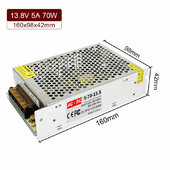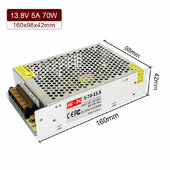I am wanting to build a small 12 volt UPS, specifically for and only for a household router. It runs on 12 volts.
There are some lithium ion powered 12 volt mini UPS setups out there for not a lot of money but I had wondered if I couldn't do a little better than that. Reviews on them suggest they're a lot like laptop batteries, which are generally good for a year or so and then die. LiFePO4 batteries are supposed to have a much longer life but I have not seen anything for sale with that type of battery. Maybe there is a problem with that type of battery in this application? If so, please tell me.
I don't need a lot or power. The router only draws something like 12 or 15 watts. And I don't need a super long run time. If the power goes out and stays out, there is time to put other backup systems in place and keep on going. But the router needs to be uninterruptible. (Don't wanna bore anyone with the details of why. Yes, the internet still works when the power goes out. If the router is live, laptops running on battery power would not know the power went out because the internet will keep on going just fine.)
So with that said, the LiFePO4 battery is quite easy and cheap. Most of them come with a basic BMS.
Output for the router is easy with a tightly controlled output of a very basic buck converter, cheap and easy.
What becomes more questionable for me is how to charge the battery? I would prefer to just use something like a wall wart to keep a trickle going to the battery all the time. But, I do not know if I would need to place some kind of a current limiter in that charge circuit such that the battery won't demand an output form that wall wart that would basically make it self destruct. Or would it? I'm thinking a solar panel would basically give what it had but not be damaged in any way by a battery that would like more current. A solar panel for this application would not be as easy to make happen here.
I could potentially put an additional buck converter in between the wall wart and the battery to control both the voltage the battery sees as well as the maximum current. (Correct me if I'm wrong about that.) They're cheap, especially in such a small size.
What do you think?
FWIW, I've been using a standard 120 volt UPS. It died last night, probably the SLA battery, I haven't dug into it yet. E02 code, I think. And I could potentially either fix that or just go back to one of those types of units. Kinda wanted to explore the mini homebuild, though and figured I'd run it past some of you. I know you're a pretty bright group... and my electronics education was long enough ago that too much is fading. Thanks!
There are some lithium ion powered 12 volt mini UPS setups out there for not a lot of money but I had wondered if I couldn't do a little better than that. Reviews on them suggest they're a lot like laptop batteries, which are generally good for a year or so and then die. LiFePO4 batteries are supposed to have a much longer life but I have not seen anything for sale with that type of battery. Maybe there is a problem with that type of battery in this application? If so, please tell me.
I don't need a lot or power. The router only draws something like 12 or 15 watts. And I don't need a super long run time. If the power goes out and stays out, there is time to put other backup systems in place and keep on going. But the router needs to be uninterruptible. (Don't wanna bore anyone with the details of why. Yes, the internet still works when the power goes out. If the router is live, laptops running on battery power would not know the power went out because the internet will keep on going just fine.)
So with that said, the LiFePO4 battery is quite easy and cheap. Most of them come with a basic BMS.
Output for the router is easy with a tightly controlled output of a very basic buck converter, cheap and easy.
What becomes more questionable for me is how to charge the battery? I would prefer to just use something like a wall wart to keep a trickle going to the battery all the time. But, I do not know if I would need to place some kind of a current limiter in that charge circuit such that the battery won't demand an output form that wall wart that would basically make it self destruct. Or would it? I'm thinking a solar panel would basically give what it had but not be damaged in any way by a battery that would like more current. A solar panel for this application would not be as easy to make happen here.
I could potentially put an additional buck converter in between the wall wart and the battery to control both the voltage the battery sees as well as the maximum current. (Correct me if I'm wrong about that.) They're cheap, especially in such a small size.
What do you think?
FWIW, I've been using a standard 120 volt UPS. It died last night, probably the SLA battery, I haven't dug into it yet. E02 code, I think. And I could potentially either fix that or just go back to one of those types of units. Kinda wanted to explore the mini homebuild, though and figured I'd run it past some of you. I know you're a pretty bright group... and my electronics education was long enough ago that too much is fading. Thanks!




